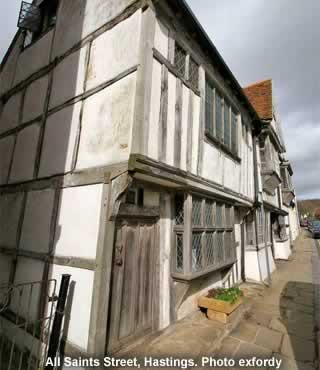Hastings |
|
 |
|||
A town once conquered by William and his Normans |
Hastings is at the heart of 1066 country. In that year, William of Normandy landed in England at a small bay to the west of town. From here his army moved inland to confront the forces of King Harold II. The battle was fierce and bloody. By the end Harold was dead, and so were most of the English soldiers. From then on, William has been referred to as The Conqueror. The Battle of Hastings became the most well-known conflict in British history. The year 1066 is etched into the brain of every schoolchild in the country. Since that year no other invading army has ever succeeded in conquering Britain. |
After his victory, the new monarch began to fortify his kingdom. The very first stone castle he built on English soil was here at Hastings. It was strong and sturdy, but unfortunately the same cannot be said for the cliffs upon which it stood. They were made of soft sandstone, which erodes easily. Over the next few centuries much of the rock collapsed into the sea, taking huge chunks of the castle with it. Nevertheless, some of the ruins are still there, and these are open to the public. |
Thankfully, Hastings didn't really need defending anyway. For many centuries this was a quiet fishing town. The boats used a stretch of the shore called "The Stade", which means "landing place" in the old Saxon language. This tradition continues today as Hastings is home to Britain's biggest fleet of beach-launched fishing boats. The town's maritime history is fully explained at the Fishermen's Museum. It's housed inside an old church, which fell out of use after World War II. The building is crammed full of aquatic items including a full-size boat. |
Along The Stade, you'll notice several unusually-shaped structures. They look a bit like garden sheds, but five times as tall. In the 17th century, the fishermen would hang their nets up in here to dry. It would probably have been easier to build the huts lengthways, along the ground, but this would have incurred a lot more tax! |
In the nearby Blue Reef Aquarium, you'll see some creatures that have never been brought back in a fishing boat. The sharks, stingrays and octopuses would give any angler a bad day. Elsewhere, an underwater tunnel gives you a close encounter with the rainbow-coloured inhabitants of a coral reef. |
The local townsfolk have never needed to worry about sharks, but once upon a time the bay had other dangers. When the night covered the town in its cloak of darkness, the smugglers arrived. They'd sneak secretly into the St. Clements caves, which were much deeper than any of the townsfolk realised. It was the perfect place to store their contraband: barrels full of alcohol, tobacco and spices. If you're brave enough, you can meet these shady characters for yourself. The caves have been transformed into a museum called "The Smugglers Adventure", which uses dramatic sound and light effects to tell its stories. |
Tourist attractions like this have sprung up everywhere in Hastings. The town started receiving a lot of visitors in the Victorian era, especially after the railway arrived. Since then it has grown into an established seaside resort, full of flashy arcades and fairground rides. There's a cinema, a theatre and a crazy golf course that regularly hosts the British championships. Elsewhere, two short railways make the steep journey up to the top of the cliffs, where you can take a broad view of the real star attraction - the beach. |
|
Pocket Britain is optimised for use on a smartphone or tablet with internet access. All content is subject to copyright. All reasonable methods have been used to ensure information supplied is accurate at the time of publication. However, it is advisable to check information before relying on it. Privacy Policy |